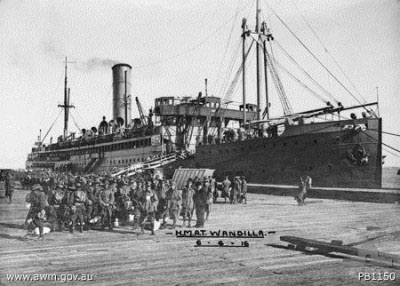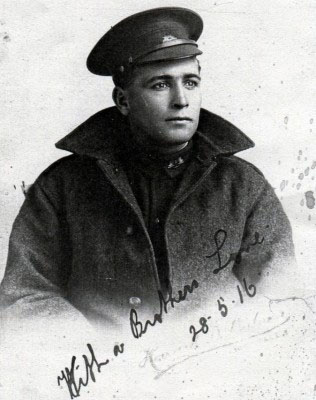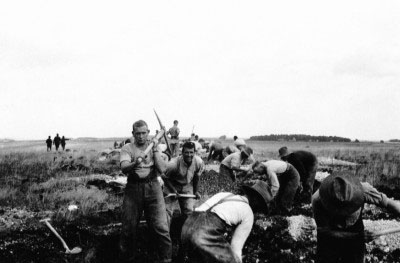Ernest William Capuano, the fifth child of Victorian-born parents, was born 31 March 1892 and grew up in the Gippsland district of Victoria. A sentinel feature of the lives of his parents Harry and Annie Capuano was their participation as active members of the Plymouth Brethren. Although Ernest did not become a member of this religious movement, he was deeply influenced by his parents’ religiosity.
Ernest Capuano left the Bairnsdale district farm in 1910 at the age of 14 and was employed by the Department of Natural Philosophy (within the Faculty of Science) at Melbourne University under Professor Lyle (later Sir Thomas Lyle) and completed four years of training in instrument making. Capuano also showed an interest in the Militia during these years. Capuano related that ‘for a period in between 1909 and 1910’, he was in the 13th Light Horse in Gippsland. If so, he most probably served with the 10th Light Horse Regiment (Victorian Mounted Rifles), which was formed in Gippsland towns in 1903. The 10th was redesignated 1912 as the 13th LHR (VMR) and in 1913 was given its territorial title as the 13th (Gippsland) Light Horse. He resigned when he left for Queensland to take up a job offer there at the University of Queensland.
From 1910 to early 1915, Capuano worked as head instrument maker in charge of the workshop in the Chemistry Department at the University of Queensland in Brisbane, under Professor Bertram Dillon Steele, first Professor of Chemistry at the University of Queensland 1910-30. With World War I underway, Capuano resigned from the University to return to Melbourne, where he joined E.A. Machin & Co. Pty. Ltd., ‘scientific instrument makers’. But in the wake of the first reports arriving from Gallipoli, Capuano was quick to enlist in the Australian Imperial Force (AIF), and joined on 14 July 1915. In his own words:
Went into Camp at Seymour 28th July with Infantry; transferred to Army Medical Corps (AMC) 4th August, was brought back to work because our firm was working on a lot of defence supplies, but was not discharged. On 11th February 1916, I was transferred from munitions and sent to Engineers Camp at Domain for pay and rations, was put in charge of respirators being manufactured at University with Lt. [Arthur Lyle] Rossiter. On the 17th February 1916 I was promoted to Sergeant. On 17th March I was transferred to the Royal Park camp for pay and rations.
On 12 May 1916, Capuano re-enlisted at Campbellfield in Victoria and this time was allocated to ‘A” Company, 3rd Pioneer Battalion, with number 232.

With his unit, Capuano left for England on the HMAT Wandila, sailing on 6 June 1916. Even as the Wandila steamed through the Heads at Port Philip Bay, Capuano was exhorting his brothers in a letter to his Father written before departure: ‘Boys, on no account enlist; it’s no place for a Christian. I’ll get through alright.’ At sea he later wrote:
…there are a lot of men fighting who are Christians. I am sure it is not God’s wish and if we are Christians and want to be Christlike we cannot go to war and kill men. Christ loved his enemies and so how can we, who belong to him go out to slay men. It is a serious thing to put a man into eternity and especially for a Christian to do it. God gave us to love our enemies…I am delighted that my Colonel has been good enough to me to study my connections and has given me a non-combatant position, for even if I was put in the front line , I could not kill men…
On the 29 June 1916 Capuano wrote:
Today for the first time on our ship we had a target hanging off the stern of the boat and had men in their turn firing at it. There was some very good shooting And it was a new bit of sport but of course I kept out of it as I always do when anything of the rifle is about as I don’t want to have anything to do with it.

Capuano arrived in England on 26 July 1916 and went into camp at Lark Hill on Salisbury Plains. He wrote:
…I thank God I am able to kneel down and thus show I am not ashamed of my Lord and Saviour …of course one gets jeered etc and because one does not go in for the vice etc as the others do one does not get as many pals as the others but God is with me & I am satisfied with his support and his company. I would be a lonely boy only for the fact that I know my Saviour & Lord.
This is a telling letter; one can only imagine what was understated in the expression ‘of course one gets jeered etc.’, but on the whole Capuano kept his head down and worked hard at his training.

It was not long after this that Capuano revealed in his letters that he was seeking to find a way to become a munitions worker. His avenue was no other than his old employer from the University of Queensland, Professor Steele, now resident in London. According to Steele’s entry in the Australian Dictionary of Biography, ‘in 1915, to help the war effort, Steele [had] returned to University College, London. His work led to a British government invitation to design, build and operate a munitions factory to produce synthetic phenol’ [author’s emphasis]. This is a highly significant connection with regard to Capuano’s plans to find a role in munitions work.
On 29 August 1916 Capuano in a letter home asks for his Father’s opinion:
I wrote to Dr Steele and he told me he thinks a transfer is possible but I will be satisfied to stay on line as long as my work is non-combatant as in the factory. I really would be only making the [shells] and blaming the other man for firing them so as far as I can see I think this is the happier place – what do you think?
Capuano appears to be genuinely conflicted, at least recognising that he is still involved in the killing, but indirectly – in a sense, the lesser of two evils from his perspective. Capuano never seems to see that by preparing shells, he actually was responsible, directly and indirectly, for the deaths and wounding of hundreds, even thousands of enemy soldiers in the course of the remainder of his war, far more than he would ever have caused by being a combatant. In his next, undated, letter home from Salisbury Plain, he writes:
One of our boys here today was transferred to munitions so…I wrote to Prof. Steele and asked him about it…and now hope that it will go through alright however I leave it up to ‘Him’…although I will be contented to go on with this as it is ‘His’ will. I would be glad to be out of it – for more than one reason. Now don’t think I am throwing up the sponge because I am getting near the front or anything like that or that I am unhappy – I am not – but this is the place that tests one I tell you and, makes me feel how impossible it is for ‘Light and Darkness’ to have any fellowship together.
As time went by, as Capuano noted, ‘in fact all our boys here say they are near enough now [to being sent to the front] and the way the boys are being slaughtered over in France does not seem to be too enticing.’ Indeed as the Pioneer Battalion increases its training tempo and the likelihood of deployment to France comes ever closer, the more efforts Capuano makes to gain clarity on his future role in the AIF. In a letter dated 23 September 1916 he writes:
Well Father, ever since I came here I have been training to be an ordinary soldier [i.e., combatant], and have appealed against it since [arrival]. ..the Major is doing what he can for me and I hope to hear of a non-combatant position within a week now.
The week went by and nothing was heard. He received a letter from the [National] Munitions Committee asking him for his details, which raised his expectations that he might get a transfer but in any case he made yet another application for a non-combatant role through his unit. Later, in a letter dated 28 October 1916 Capuano says that ‘it seems very hard to get anyone out of the Aust. forces unless one has a chemist’s degree or suchlike.’ Training for the front intensified – he went on to write: ‘All this week I have been learning bayonet fighting and it is a ghastly trade I can tell you.’
Then, on 6 November he wrote: ‘On Saturday morning the Adjutant sent for me & I went down & he wanted to tell me about a transfer…’; on 12 November his letter home reported that suddenly a transfer had been arranged after Capuano put in yet another request, this time to transfer to the 22nd Australian Army Service Corps, 3rd Division Train. This request must have been the final straw for the unit commander after many such requests – a transfer was immediately organised and within 10 minutes he was a driver in the AASC. Elements of the 3rd Pioneer Battalion were already in combat in France and the rest were following closely behind.
Capuano’s story continues in Part 2.
Contact Andrew Kilsby about this article.






